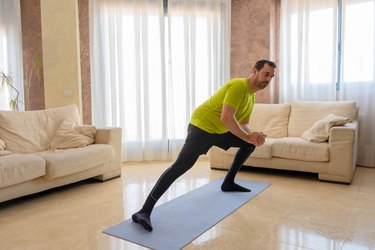
When you were a spring chicken, you had a certain, well, spring in your step. But lately you're noticing your knees are a lot less limber. Sound familiar?
For many of us, Father Time can bring tight, stiff or sore knees. But knee pain isn't inevitable. While you can't completely age-proof your knees, there are smart steps you can take to prevent serious problems.
Video of the Day
Video of the Day
Here, Elizabeth T. Nguyen, MD, a physiatrist board-certified in physical medicine and rehabilitation at the Hospital for Special Surgery, explains what causes knee pain in older adults and what you can do to decrease the discomfort.
1. Your Cartilage Deteriorates
"Cartilage protects bones and joints and serves as the shock absorber within the knee joint," Dr. Nguyen says. In other words, this connective tissue is a crucial cushion for your body's structures.
But over the course of your lifetime, cartilage tends to deteriorate due to normal wear and tear. When this happens, "there is less shock absorption and increased stress along the joint, which can potentially lead to knee pain," Dr. Nguyen says. (Although not everyone with cartilage wear experiences pain.)
Fix it: Strengthening exercises offer the best form of prevention and management for knee pain related to cartilage deterioration, Dr. Nguyen says. Specifically, you can support your knees by focusing on muscle groups that move and protect the knee joint.
For example, strong quads (the group of muscles on the front of your thigh) are crucial for knee health. In fact, "studies have demonstrated the relationship between quadriceps weakness with [knee] pain," Dr. Nguyen says. So, building up your quads will play a big part in preventing knee problems down the line.
In addition, minimizing repetitive overuse of the knee joint and maintaining a healthy weight for your body (more on this later) are also key for healthy knees in your golden years, she says.
2. You’ve Gained Weight
Age-related weight gain is common thanks to things like a slower metabolism and a more sedentary lifestyle. But having overweight is a risk factor for developing knee pain, Dr. Nguyen says.
That's because the more weight you carry, the greater the strain on your knees.
"Weight gain can increase the load and stress across the knee joint, which may contribute to knee pain, inflammation, stiffness and loss of functional mobility," Dr. Nguyen says.
But that's not all. "Obesity can also contribute to low-grade levels of systemic inflammation that can affect multiple joints," she adds. And chronic inflammation can produce joint pain or stiffness, according to the Cleveland Clinic.
Fix it: Even losing a little weight can make a big difference in knee discomfort.
"Losing one pound of body weight can reduce the stress across the knee joint by approximately four-fold," Dr. Nguyen says. "For example, a weight loss of 10 pounds can lead to a reduced load of around 40 pounds across the knee joint."
3. Your Muscles Are Weaker
While it's a natural part of the aging process, you can expect to lose up to 5 percent of your muscle mass every decade after the age of 30, according to Harvard Health Publishing.
But age-related muscle loss, known as sarcopenia, equates to greater weakness and less mobility, which can harm your knee health.
"Muscles, such as the quadriceps muscles and even the gluteal muscles along the hip, have important roles in moving and stabilizing the knee joint," Dr. Nguyen says. "The quadriceps muscles also carry the role of absorbing the stresses applied to the knee."
"When these muscle groups are weak, this can lead to abnormal joint loading, joint instability, structural injury and eventually pain," she explains.
Fix it: Again, strength-training to keep your quadriceps robust is a really smart strategy for maintaining healthy knees. Movements that target your hamstrings will also help support your knees, according to the Mayo Clinic.
"Strengthening exercises, such as isometric exercises or resistance-band exercises, can properly address weaknesses to optimize strength and stability," Dr. Nguyen says.
For healthier knees, you should also incorporate balance training into your weekly routine. Balance training teaches the muscles around your knees to coordinate more efficiently, which translates to better knee function and fewer risks of injury, per the Mayo Clinic.
4. You’re Too Sedentary
Your twilight years are a terrific time to take it easy. For many older adults, that often means moving less. The problem is, excessive sitting can sabotage your knees.
Indeed, inactivity can speed up the shrinking and stiffening of cartilage, leading to less joint mobility and range of motion, according to the State Government of Victoria's Department of Health. Translation: less limber knees.
What's more, staying active puts a certain amount of healthy stress on your joints and supports the flow of synovial fluid (i.e., the lubricating fluid inside your joints), per the State Government of Victoria's Department of Health. So if you sit most of the day, you lose this lubricating effect.
Being too sedentary can also cause muscle deconditioning and weight gain, Dr. Nguyen says. And, as we know, both factors can potentially lead to knee pain.
Fix it: Staying active is the secret to healthy knees. (Starting to see a pattern here?) Stretching, which can temper tight muscles that trigger a tendency for injury, and strength training are both stellar options.
5. You Have Osteoarthritis
Knee osteoarthritis is a painful degenerative disease that affects the cartilage, bone and tissues that line the joint, Dr. Nguyen says.
"Part of this disease process involves an increase in the enzymes that are responsible for cartilage degradation, which lead to cartilage loss, inflammation, pain, stiffness and loss of mobility," she says.
While this progressive knee problem is associated with older age, not everyone develops osteoarthritis, which differs from normal aging of the joint, where the cartilage is still relatively healthy, Dr. Nguyen explains.
Still, this condition is incredibly common, as it affects an estimated 80 percent of adults older than 55 (with 60 percent experiencing some symptoms), according to the Cleveland Clinic.
The following factors increase your odds of osteoarthritis, per the Cleveland Clinic:
- Overweight or obesity
- Diabetes
- Elevated cholesterol
- Sex (people assigned female at birth are more susceptible)
- Genetics
Fix it: While certain risk factors are beyond our control, others can be modified to prevent the onset or progression of osteoarthritis, Dr. Nguyen says.
"Management depends on the intensity of the pain, severity of the condition and the individual's functional goals," she says.
For example, a person dealing with obesity may work on healthy weight management to minimize symptoms. Shedding a few pounds can help mitigate pain, inflammation and the advancement of the disease, Dr. Nguyen says.
So how much do you need to move the scale's needle to see the benefits? "Losing greater than10 percent of your current body weight can lead to significantly improved pain, function and quality of life," she says.
Not only can weight loss combat symptoms, but it can also drastically decrease the risk of developing knee osteoarthritis in the first place, Dr. Nguyen adds.
Other conservative treatments for the condition include, per Dr. Nguyen:
- Low-impact aerobic exercise (think: walking, biking, swimming)
- Physical therapy to improve strength, flexibility and functional mobility
- Knee bracing to temporarily offload stress from the knee joint
- Topical or oral medications, such as acetaminophen and/or non-steroidal anti-inflammatories to relieve pain and inflammation
- Therapeutic injections such as corticosteroids or hyaluronic acid
In advanced cases where conservative treatments don't help, knee replacement surgery can be considered, Dr. Nguyen adds.
6. You’ve Had a Previous Knee Injury
Sorry to say, but if you have a history of hurting your knees in your younger years, it may come back to bother you later in life.
"Previous knee injuries, such as a fracture, cartilage injury or ligament injury, are a risk factor for post-traumatic osteoarthritis," Dr. Nguyen says.
"These injuries can lead to altered neuromuscular control, abnormal joint loading, decreased knee mobility, increased joint instability and ultimately cartilage deterioration," she explains. All of which can lead to knee pain in older age.
Fix it: Working with "rehabilitation specialists familiar with the injury will help in preventing the onset and progression of osteoarthritis," Dr. Nguyen says.
For instance, a physical therapist can assist you in "addressing the underlying mobility, strength and functional deficits through activity modification and therapeutic exercises," she says.
7. You Have Gout
Gout — a type of inflammatory arthritis — may be the cause of your knee pain.
While gout can affect you at any age, it's more common after menopause, according to the Cleveland Clinic.
This painful form of arthritis "usually involves one joint at a time and is due to an increase in blood uric acid levels," Dr. Nguyen says.
Uric acid is a normal byproduct created when your body breaks down compounds called purines, which are found in certain food and drinks, including alcohol and animal proteins, per the Cleveland Clinic. In healthy people, uric acid gets filtered through the kidneys then excreted through urine.
But when your body overproduces uric acid, or your kidneys aren't functioning properly, "uric acid crystals can accumulate within joints, which leads to inflammation and pain," Dr. Nguyen says.
On top of pain, gout can also cause the following symptoms, per the Cleveland Clinic:
- Redness
- Stiffness
- Swelling
- Tenderness, even to light touch
- Warmth, or a feeling like the joint is "on fire"
Fix it: Along with maintaining a healthy weight for your body, "gout recurrences can be managed through dietary changes, such as reducing intake of red meat, shellfish, alcohol and sugary drinks that contain fructose," Dr. Nguyen says. Limiting these foods, which are high in purines, can help combat uric acid buildup.
In addition, "anti-inflammatory medications can manage pain and inflammation during flare-ups," she adds.
When to See a Doctor for Knee Pain
While some stiffness in your joints is to be expected as you grow older, knee pain isn't a natural part of the aging process.
So if your achy knees interfere with your daily activities or with sleep — and are not relieved by a reasonable period of rest, ice, compression, elevation and over-the-counter pain relievers — it's time to see your health care provider, Dr. Nguyen says.
Likewise, if your knee pain is caused by an acute injury that results in swelling, intense pain and/or an inability to walk, see your doctor immediately, she says.
Is this an emergency? If you are experiencing serious medical symptoms, please see the National Library of Medicine’s list of signs you need emergency medical attention or call 911.








